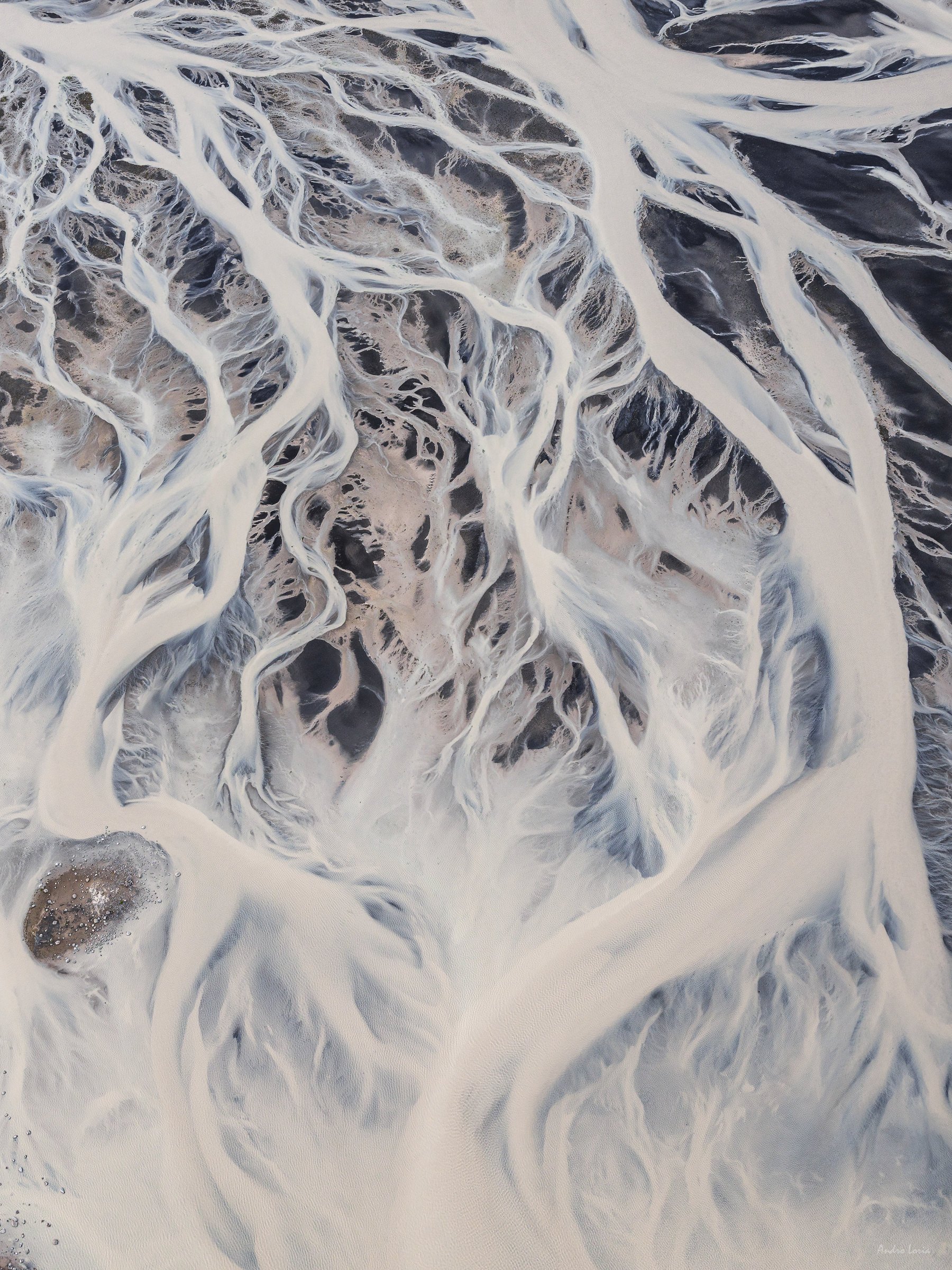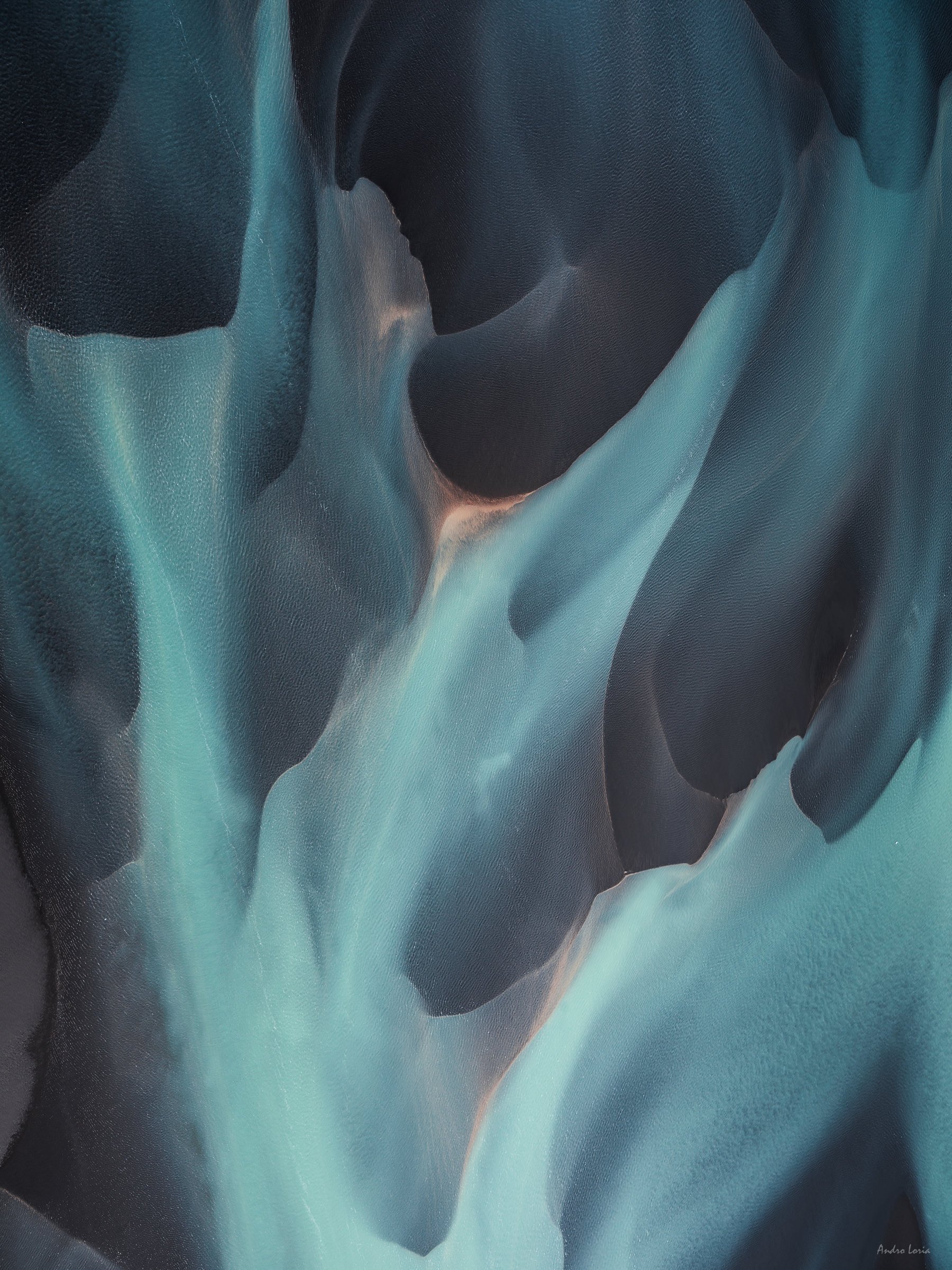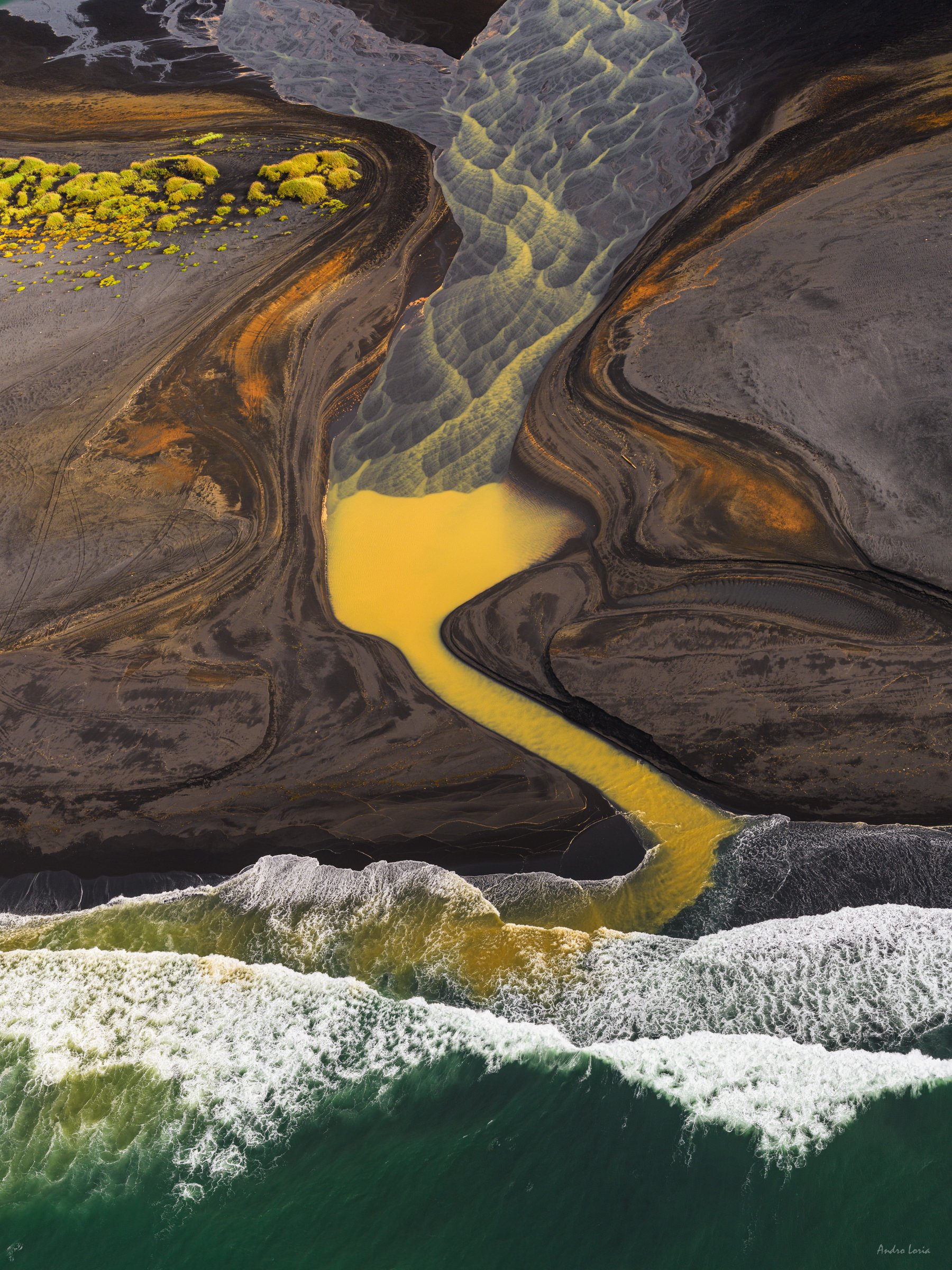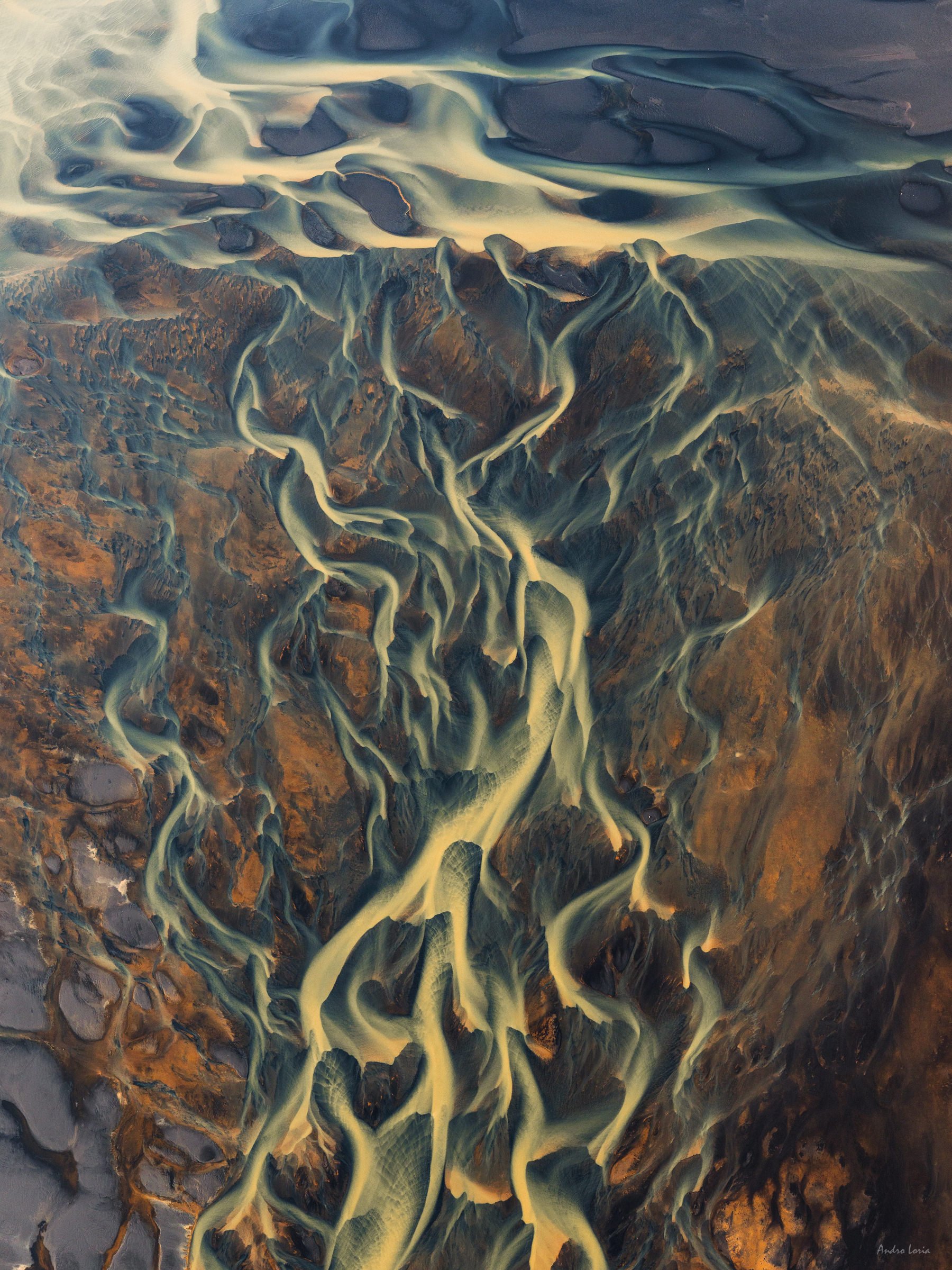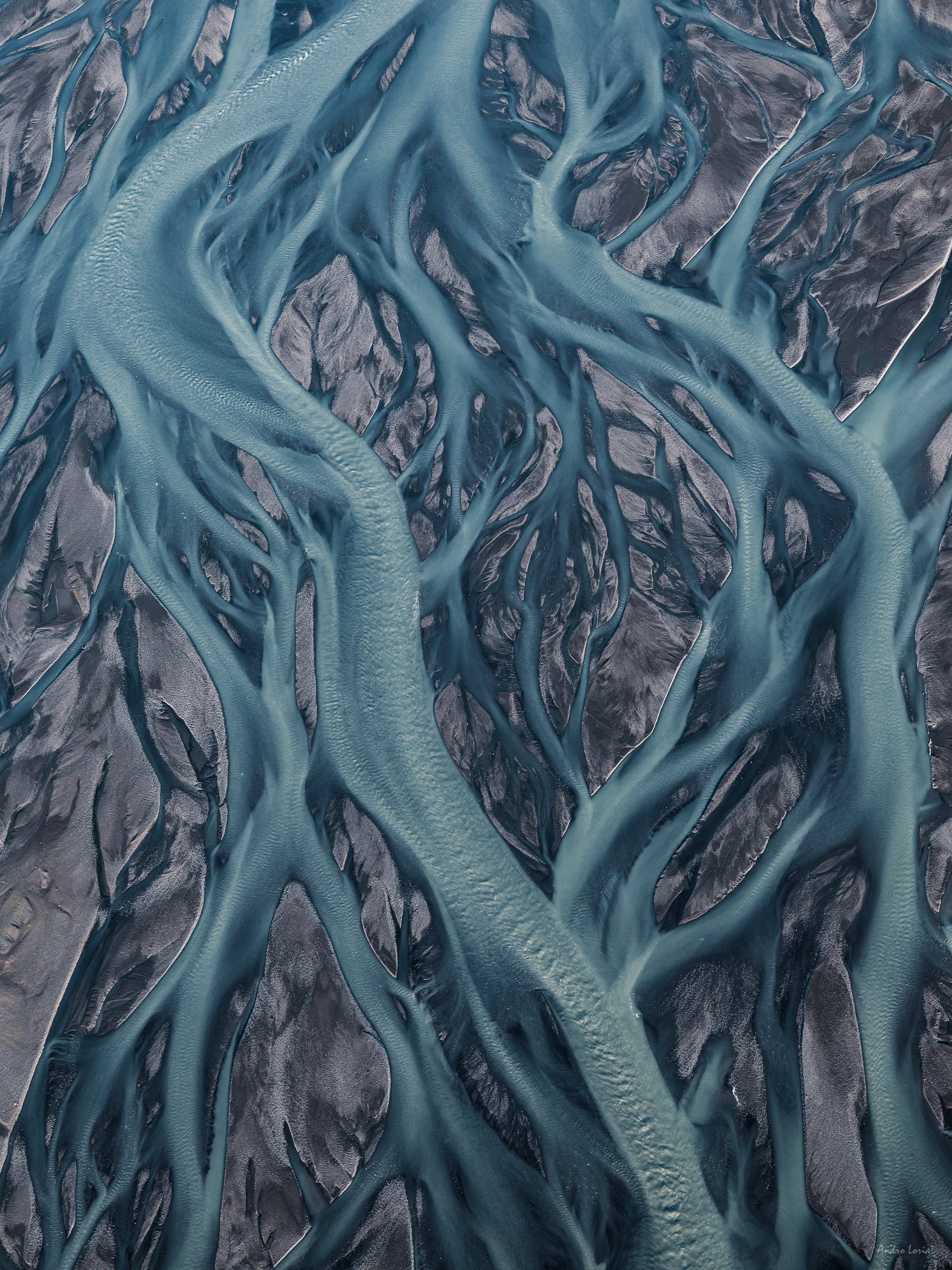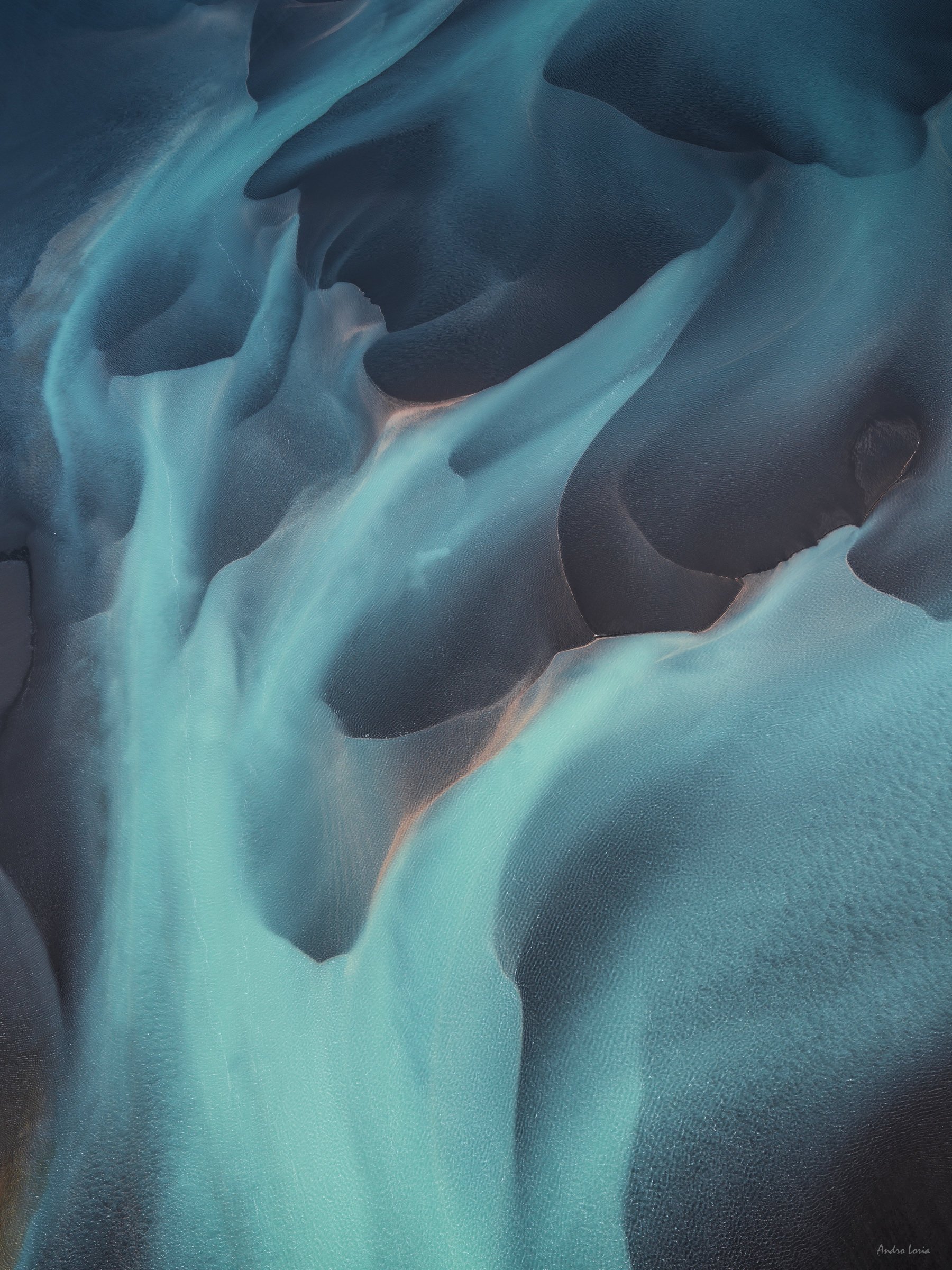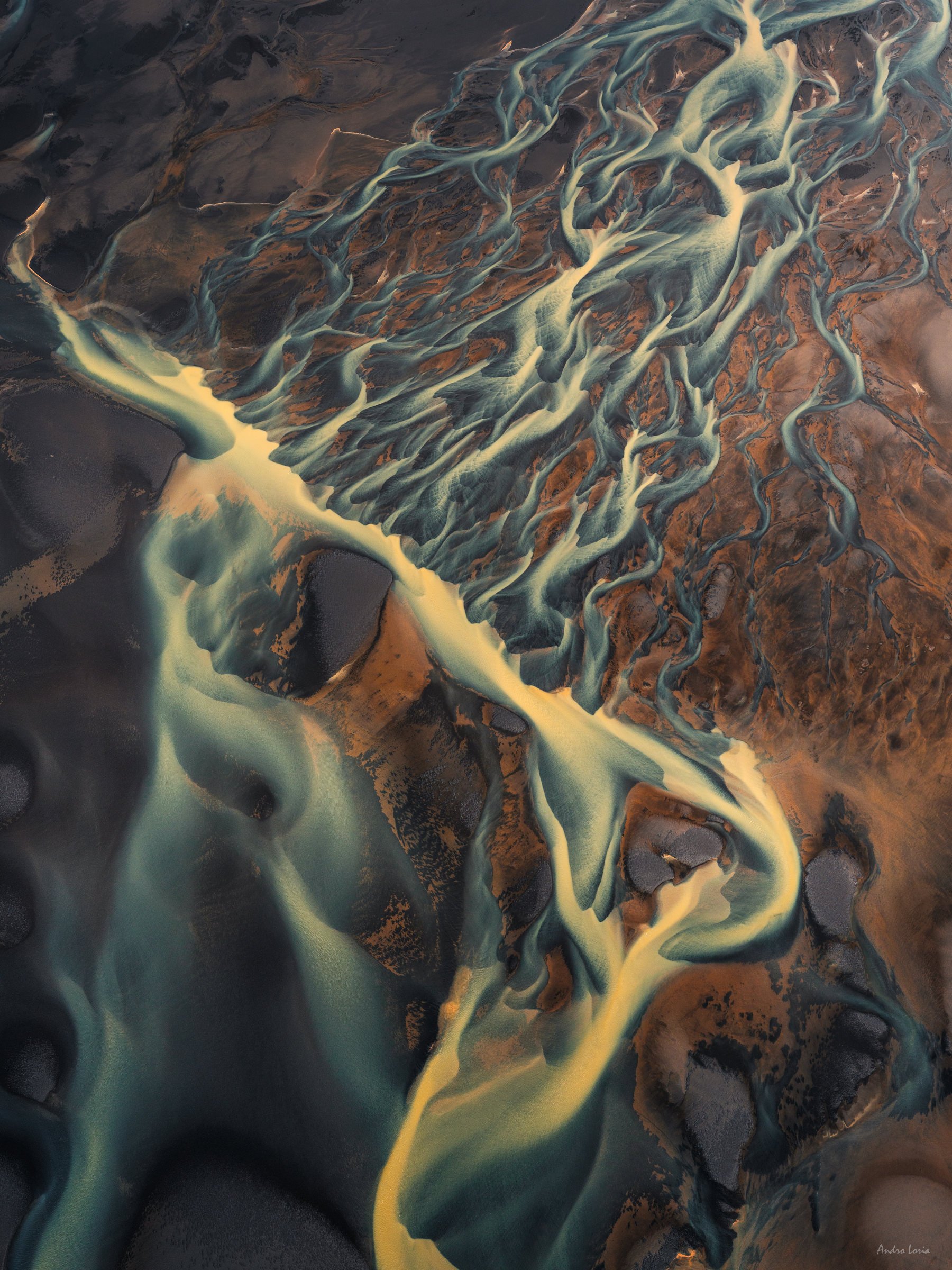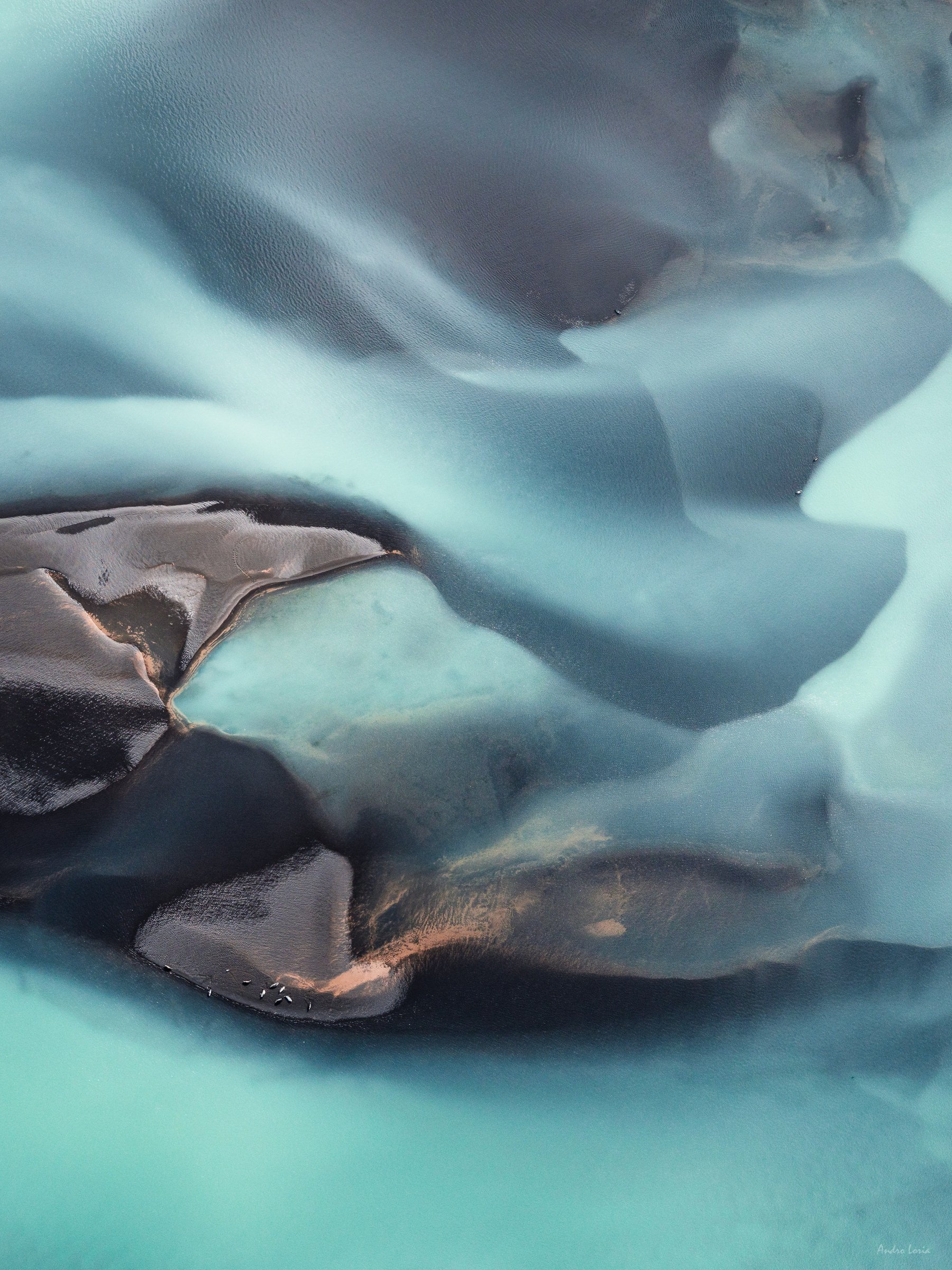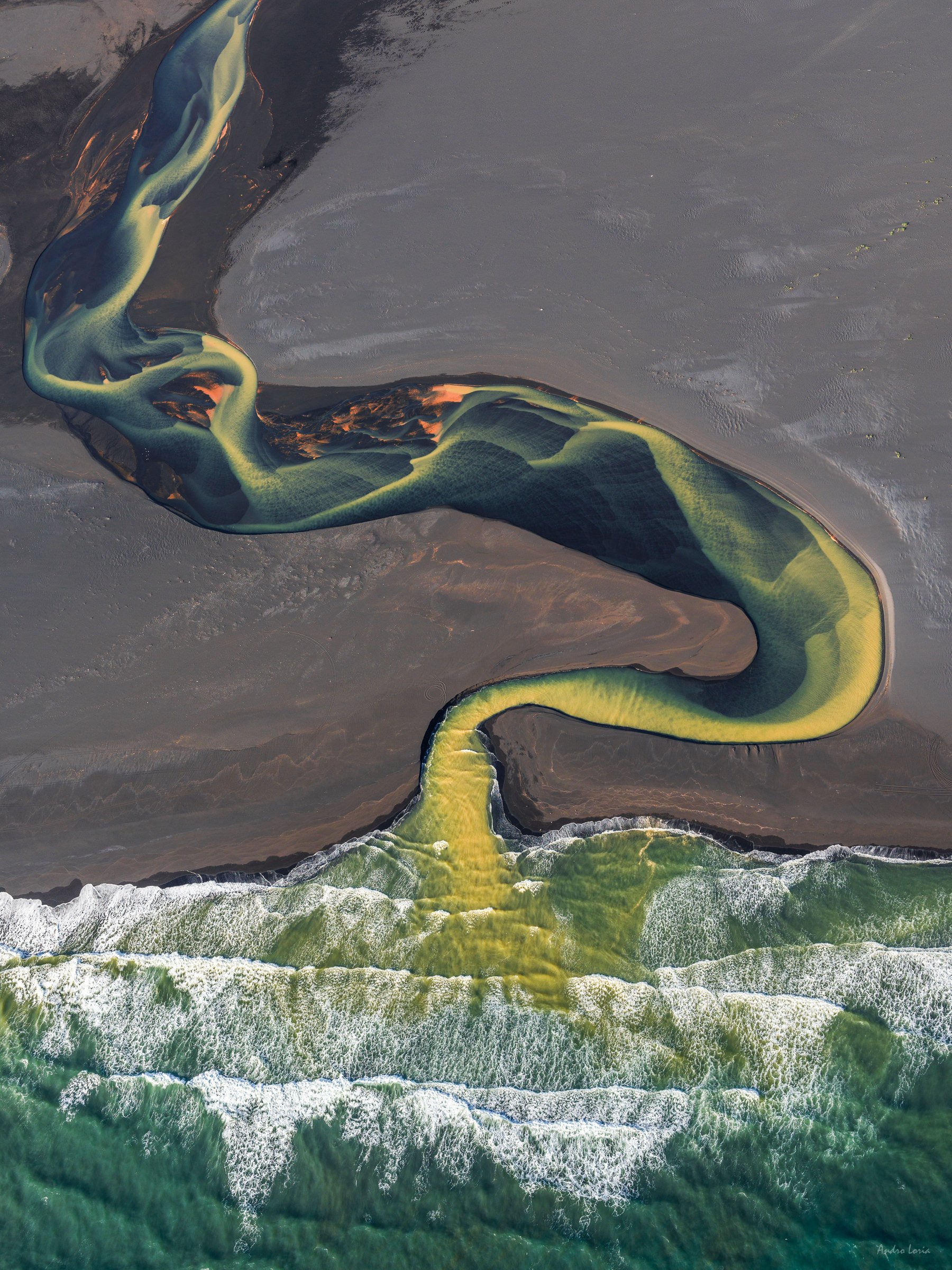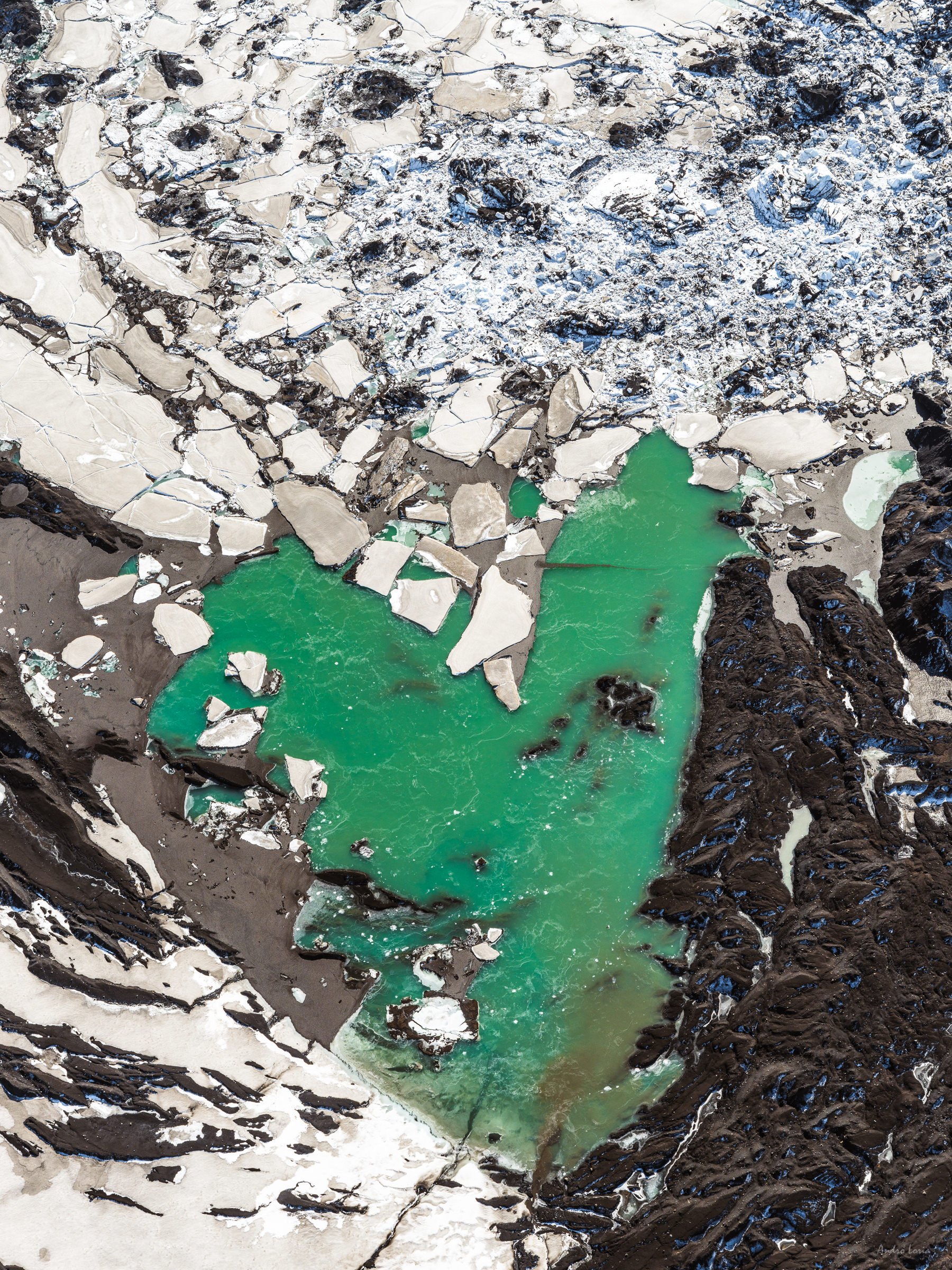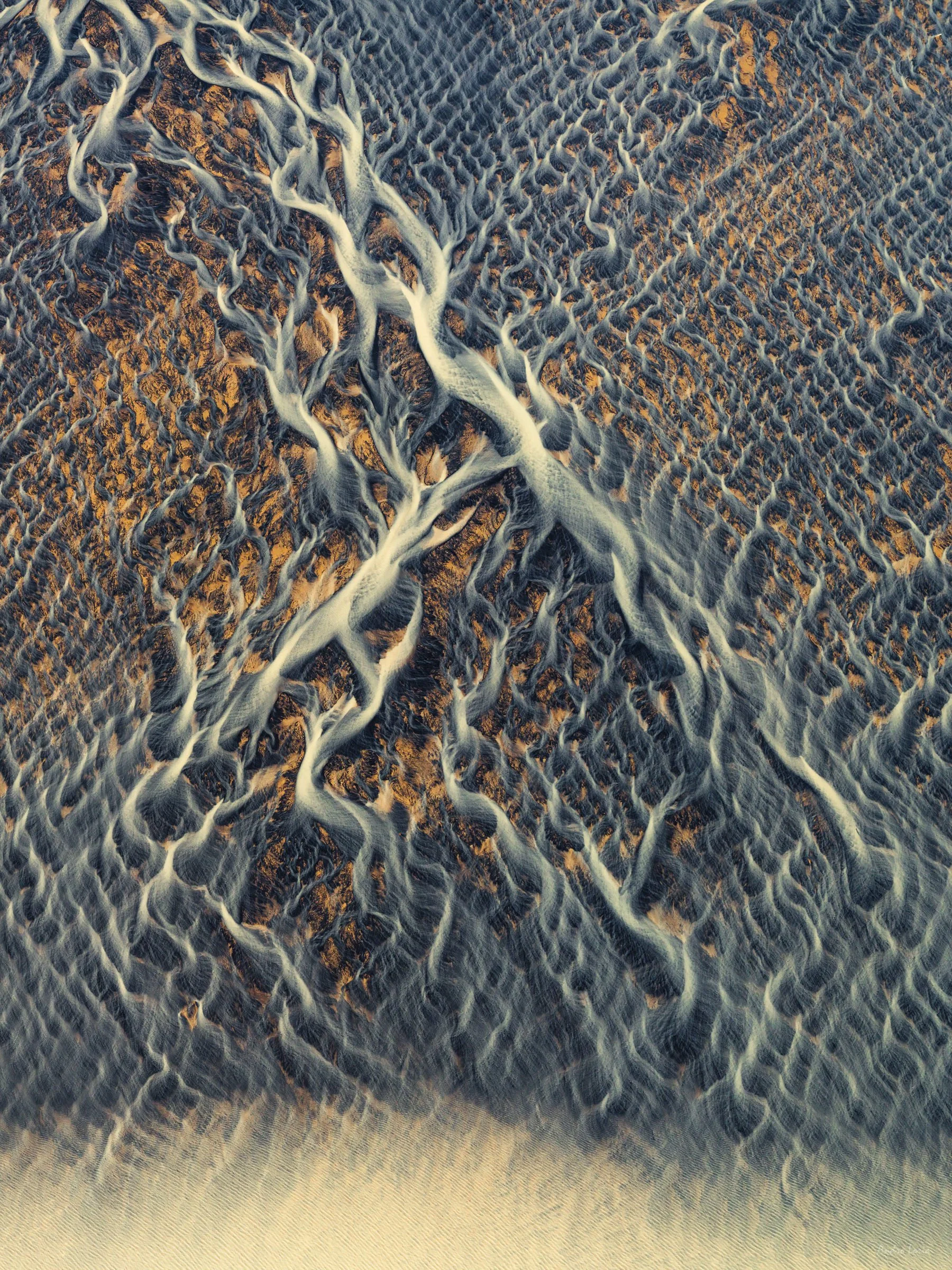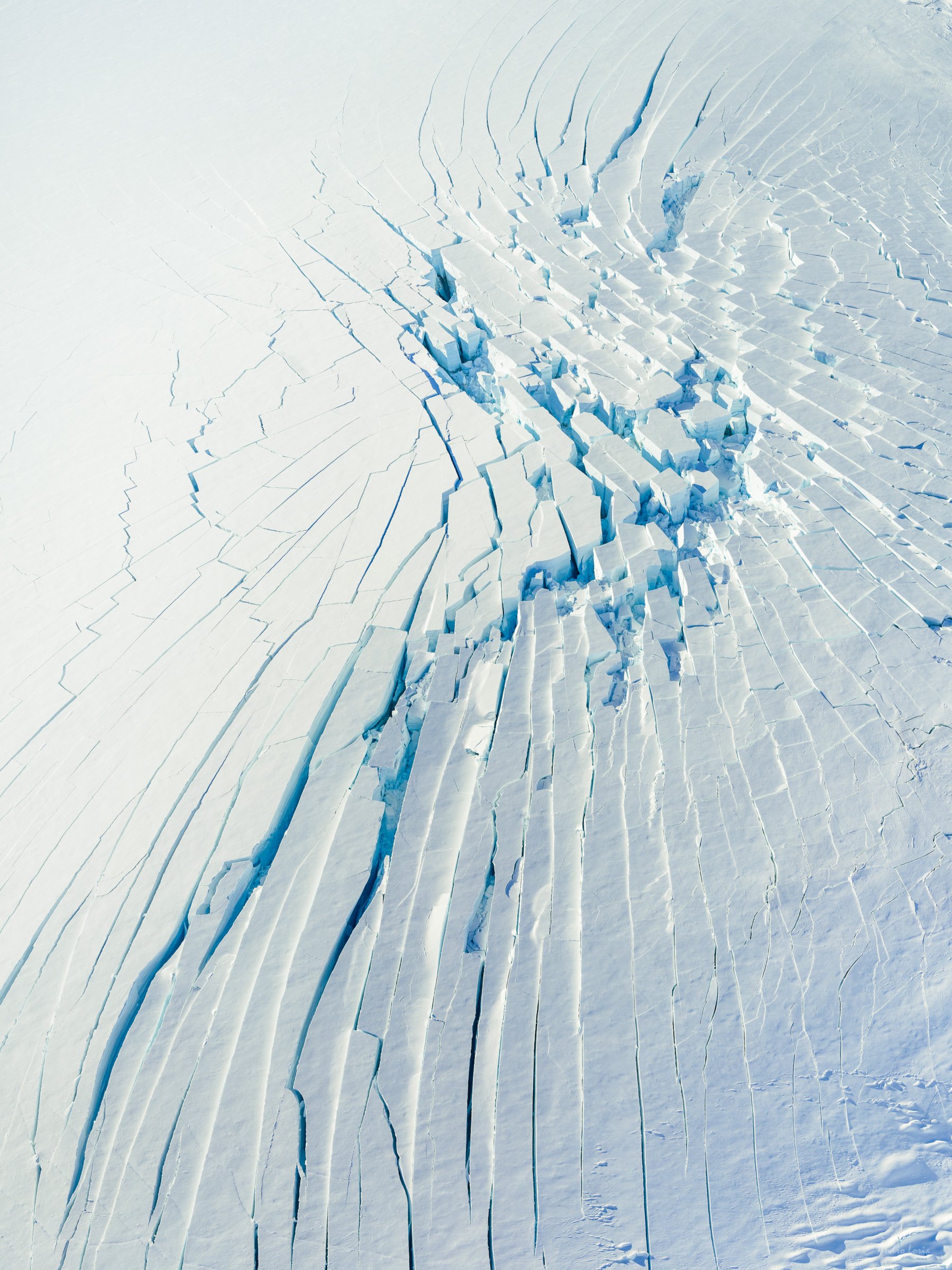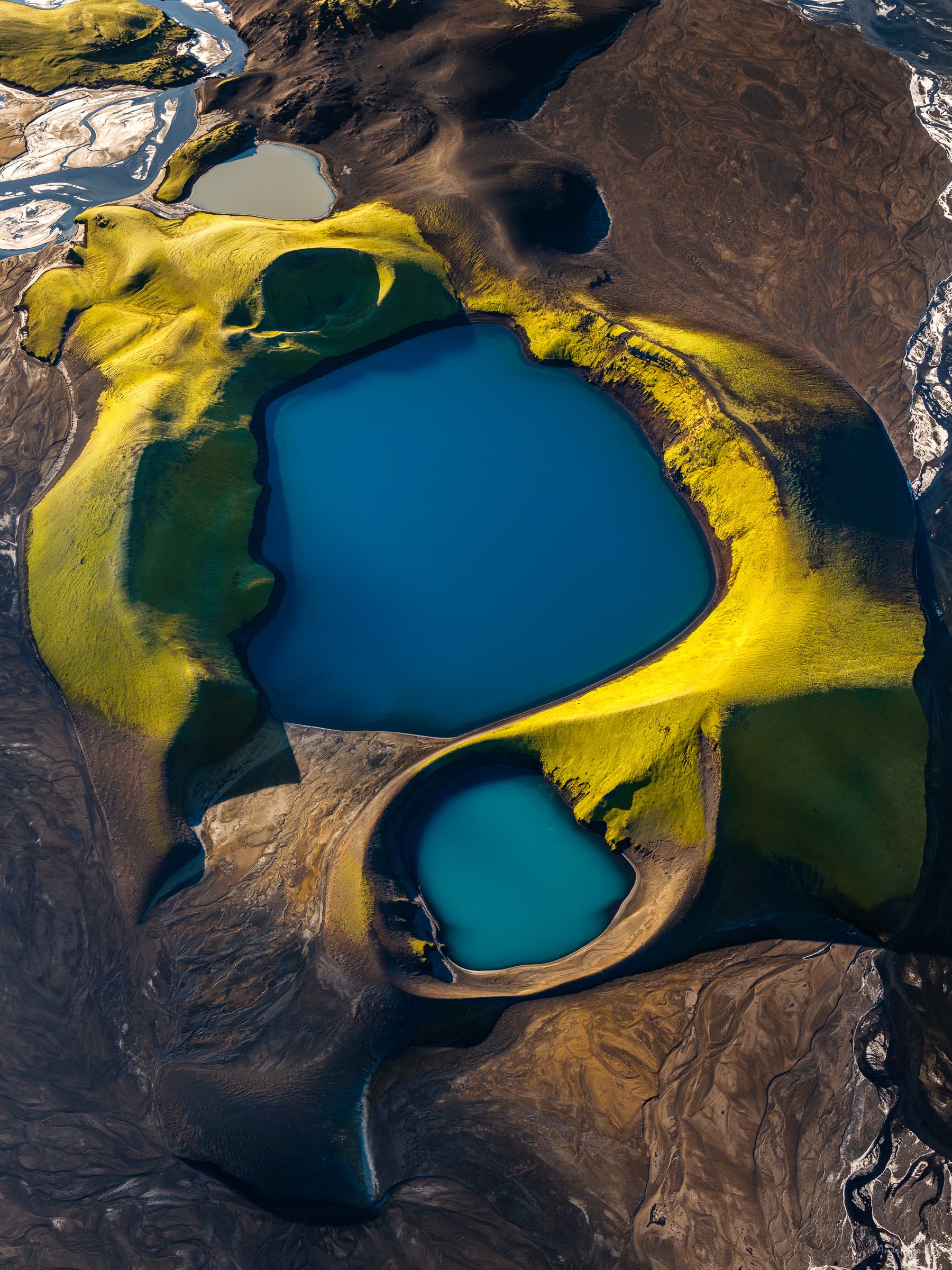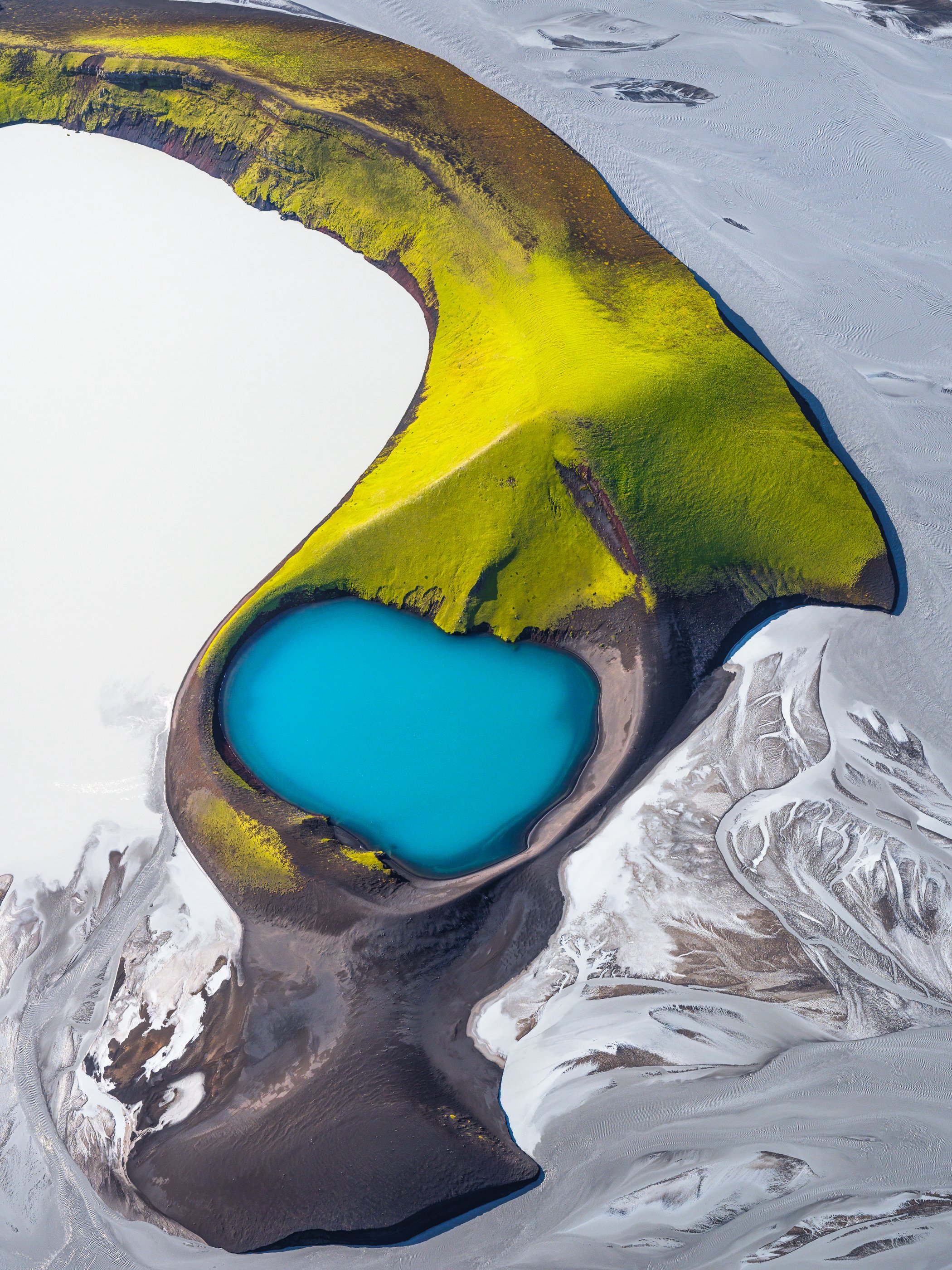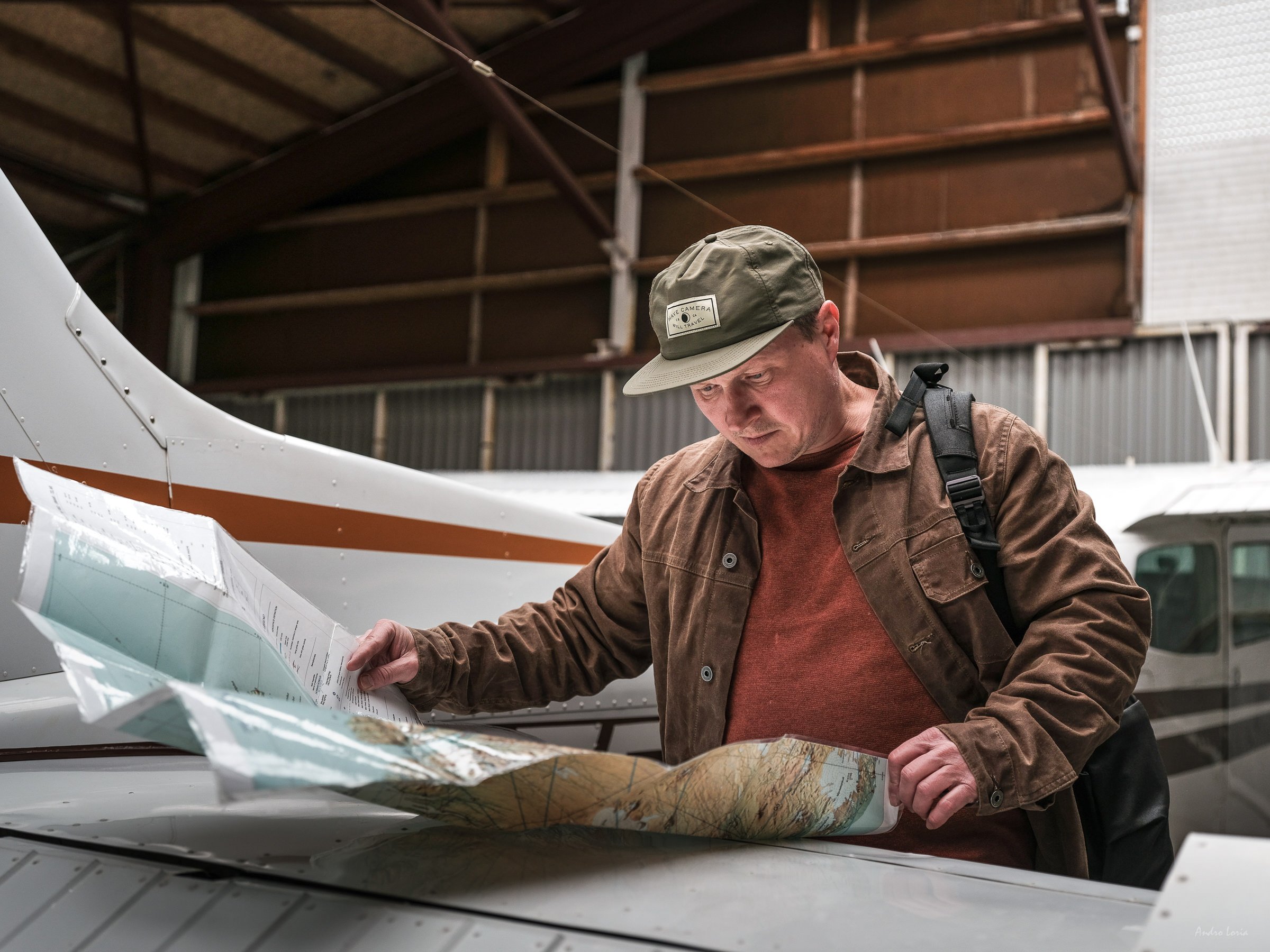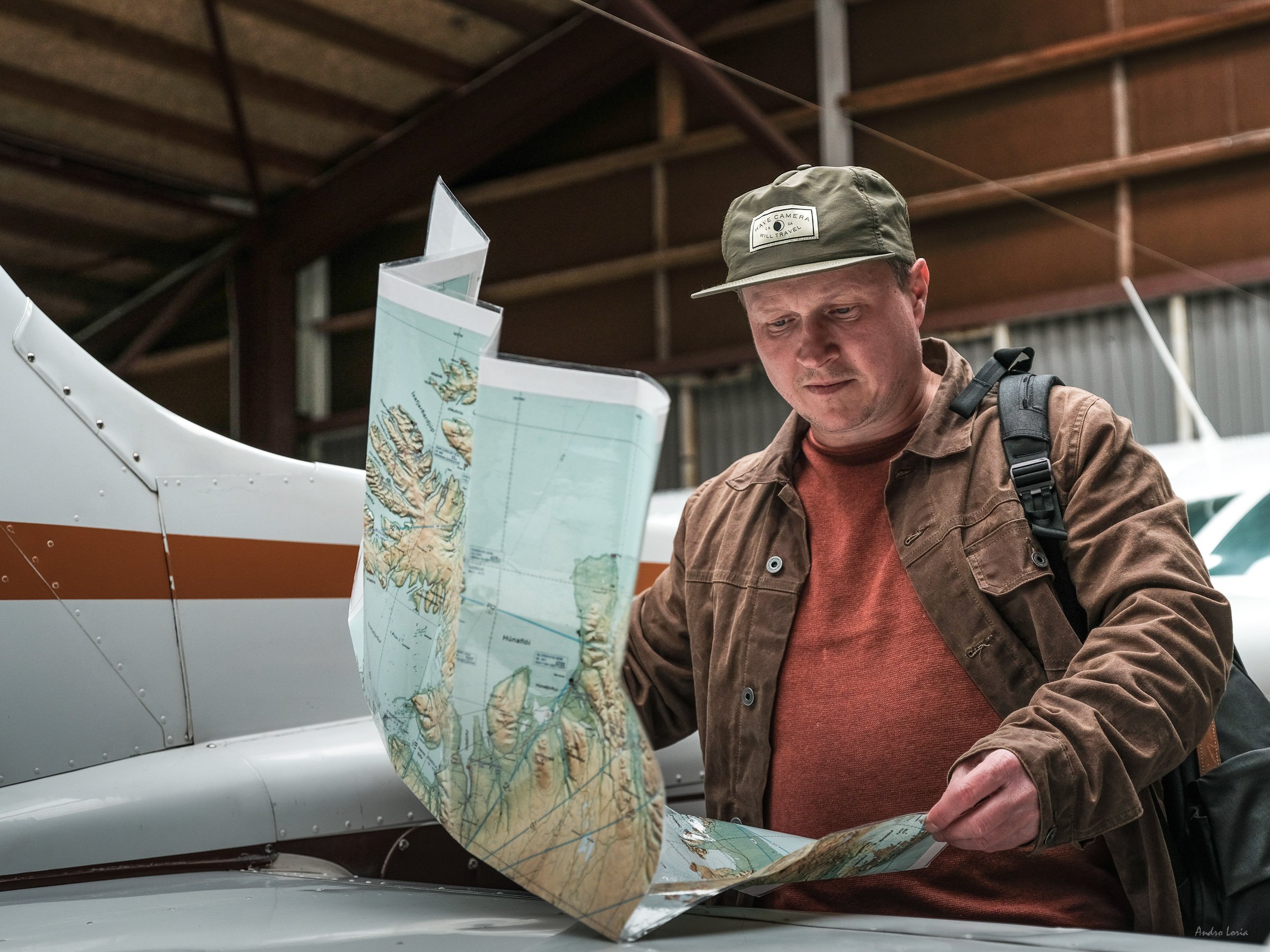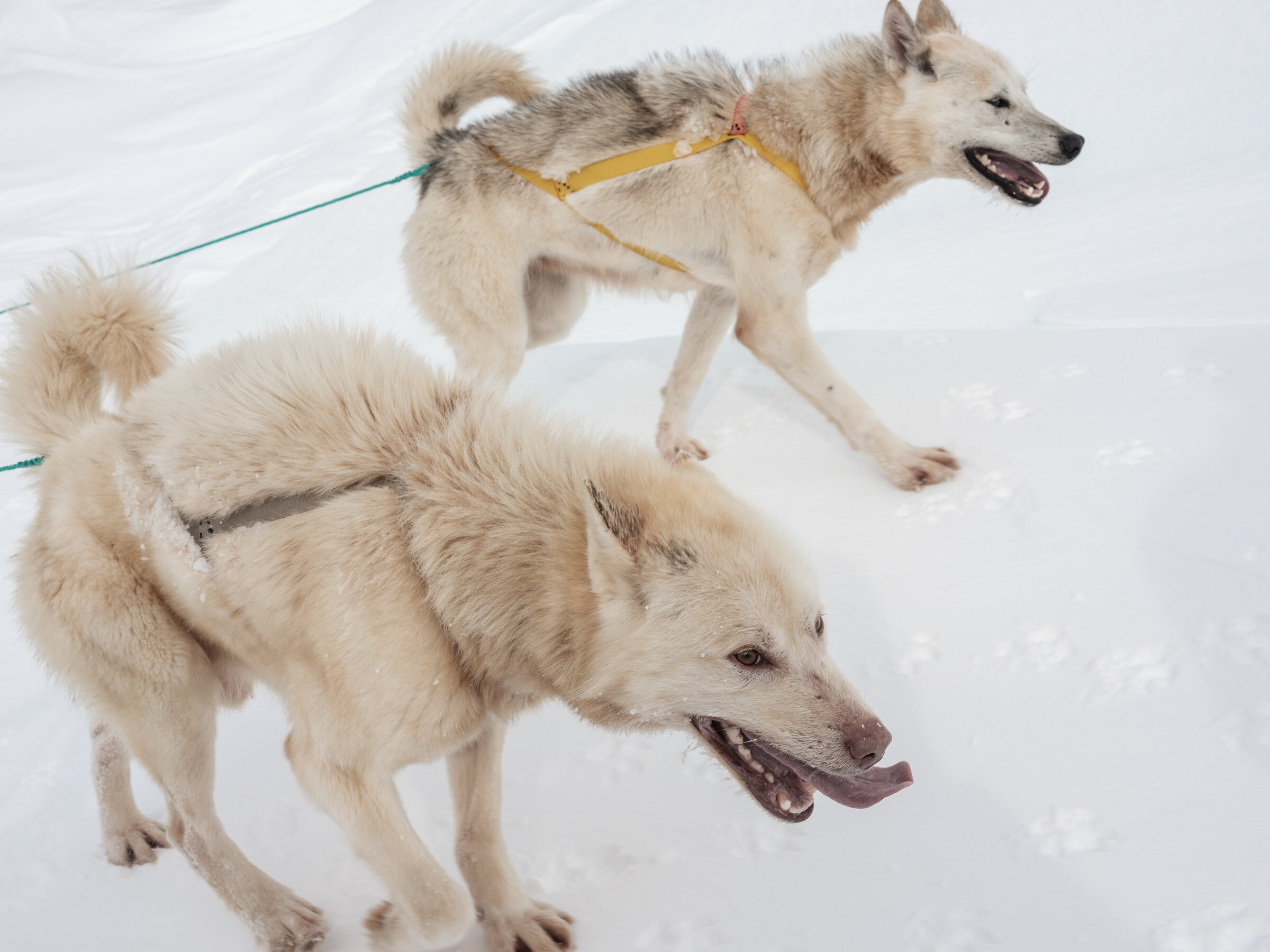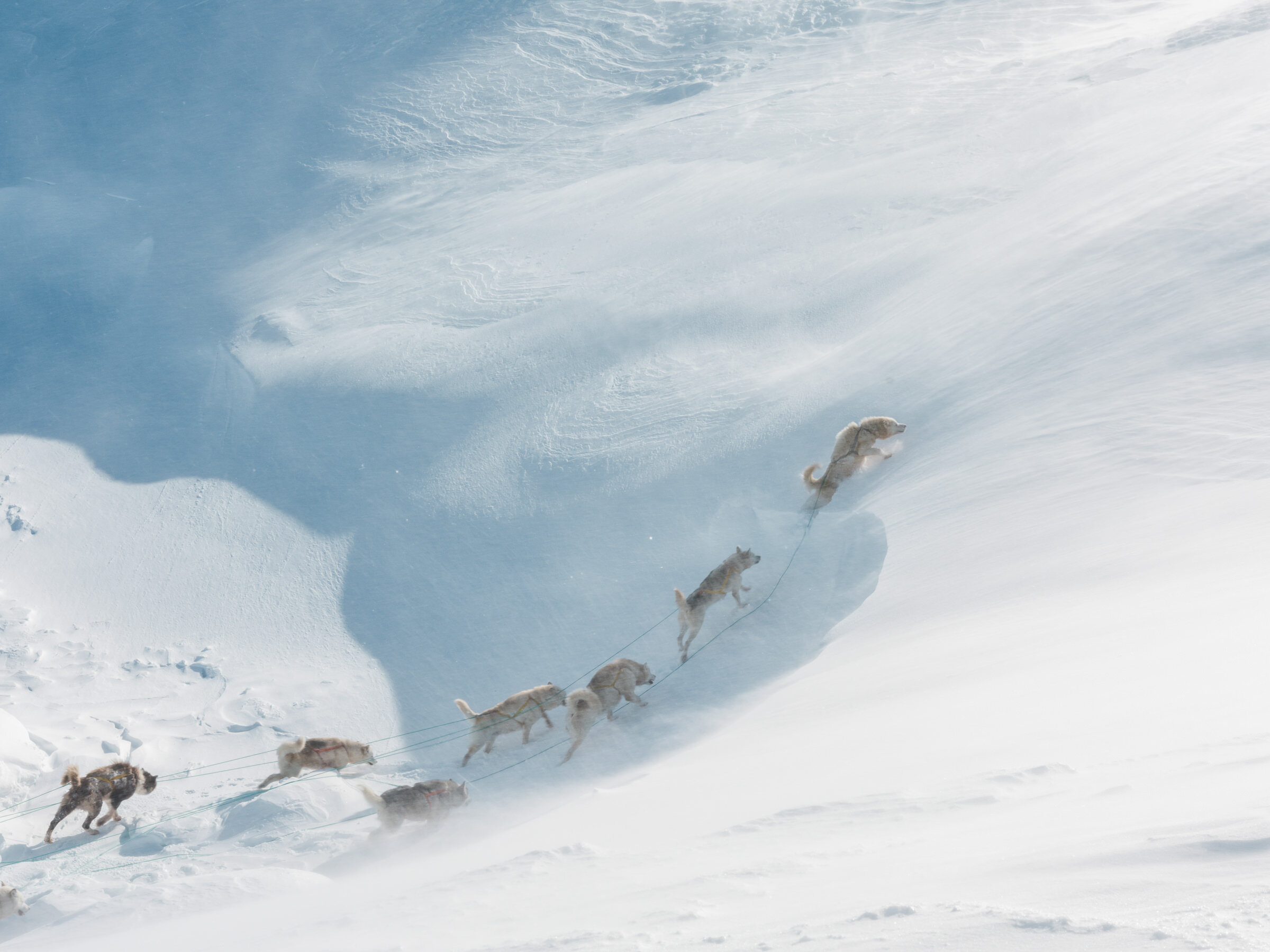This post is about flying over Iceland. Over the past five years my focus has mostly been on aerial photography, something I started to think about during my first few visits to Iceland almost 10 years ago when I was taking photographs on the ground. From my experience of mountain trekking I knew that the view from the top is unbeatable, so, I had to try shooting from the air and this was only encouraged by amazing shots by those lucky few (those pre-drone era days) who managed to see and capture fractals of Icelandic braided rivers, abstract patterns and the colours of Africa and South America etc.
Glacier's necklace - glacial pools (kettles) form a giant nordic "necklace" pattern at the edge of piedmont type glacier when seen from above - about 5k ft. Central highlands.
Glacial silk - silt and mineral coloured glacial streams look like silk ribbons when seen from 3000 ft above, creating a natural abstract. South coast of Iceland.
Autumn highlights - late autumn snow and low sun highlight the tops of the mountains and steam from the geothermal vents in the Icelandic highlands.
In 2017 I was lucky to meet a wonderful human and pilot, who was also an excellent photographer, and later become a great friend, the late Haraldur Diego ( @volcanopilot ); flying with him changed my life and photography. Sadly, Haraldur tragically died last winter, so this narrative is partly aimed to put some of those wonderful visual and emotional memories together and hopefully to give some encouragement and advice to those who are keen to try aerial photography and want to get airborne with their camera, so this will be a long story with about ninety images taken during different flights over the last four years :)
Convergence - three white birds (gulls, centre) show the enormity of glacial streams’ convergence that gives birth to a river at the western edge of Vatnajökull, as seen from above (>1200ft). The streams are coloured by different minerals and silt. Vatnajökull, Iceland,
Oasis - moss on the mountain slopes contrasts the blue of the crater lake and the silt-rich grey of Skaftá river during a glacial run in the Southern highlands
Glacial forest - glacial streams coloured by silt run from Vatnajökull forming a tree-like natural abstract when seeing from above from about 3000ft.
Highlands - glacial rivers and lakes, black volcanic sand, luminescent moss on moisture-rich areas and mountain slopes, ever changing weather - all combine to create Icelandic natural art.
The uniqueness of the views, the ever-changing patterns of landscape and light and fast changing scenery all make aerial photography very challenging, but also very rewarding. The views from above in Iceland are like views from a different planet and often have an other-worldly feel about them. Sometimes they look like a vascular system, nature repeats its patterns, and sometimes like a giant neuronal network laid out on the ground. Seeing and photographing from the air is both a challenge and an immense pleasure and privilege.
Seals on the sand banks of the Ölfusá river, South coast of Iceland.
Yggdrasil - or what looks like the top section of a mythical tree is a combination of glacial river streams that carry silt and minerals from the nearby glacier, Langjökull, to a small lake and in doing so, create some of the best abstract natural art in the world.
Flames - silt-coloured streams of a glacial river as seen from a couple of thousand feet above.
Birds over Ölfusá river, South coast of Iceland.
Heart on fire - glacial river streams carry silt and minerals over colourfull volcanic sand and create an amazing scenery that looks like the flames of a fire forming a heart shaped pattern when seeing from above. Or maybe it is a first sighting of Groot in Iceland? ;)
A few gulls - white specks over converging streams of glacial flow coloured by silt and minerals at the edge of the Vatnajökull glacier. From above (~3000ft) it looks like a natural abstract.
At first, on your first couple of flights, everything happens very fast, perhaps too fast. You have no time to see everything coming at you and you barely have time to frame, compose and change the settings on your camera and lens. With time, playing with light and composing from a fast moving aeroplane becomes great fun and even when you take a few fly-overs, typically in circles, over a specific area that caught your eye and mind, it never really looks the same, as the light and shadows from the clouds and mountains move. You can gain or drop some altitude and so the angle of view and the shot(s) changes too and with them your feelings and ideas about how to frame the shot.
Autumn in Iceland - autumn (mid-October) snow and low sun highlight the highland’s landscape and the colours at Landmannalaugar, Iceland.
Green moon travel - amazing landscapes of Iceland are best seen from the air. A moss covered old crater looks like it belongs to a different planet or moon. See a couple of 4x4 cars on the road for scale and a couple of people (purple jackets) on the right side of the crater.
Glacial patterns - amazing patterns on the top of Mýrdalsjökull glacier ice cap, formed by the glacier's flow and erosion look like a giant-scale natural abstract art.
Abstract highlands - moss on the mountain slopes contrasts the blue of the crater lake and the silt-rich grey of Skaftá river during a glacial run in the Southern highlands.
One can do aerial photography from either small aeroplanes or helicopters. You can find more useful information here written by Haraldur a while ago, I won’t repeat what was written by the Master, albeit reiterate some messages from the photographer/passenger point of view. I have excluded drones from my list, as this narrative is about flying and shooting, not operating a flying device from a ground position. Drones can be a great fun, especially when using longer exposures, but they are way behind in terms of camera and sensor quality and do not come even close when it comes to the feeling of flight.
Glacial patterns - glacial river streams running from the Langjökull glacier flow into a small lake forming abstract natural art when seen from above at ~1200ft.
Autumn light - late autumn sun highlights moss on the mountain slopes in the Southern highlands.
A pair of gulls - two white specks in the centre of the right half of the frame - fly over converging streams of glacial flow coloured by silt and minerals at the edge of glacier. ~3000ft above of the edge of Vatnajökull glacier.
Before the flight - For photography purposes try to get a Cessna type plane rather then a Piper type. The former has windows that can open to give you an unobstructed view and field of work. The best seat is at the front seat next to the pilot. Do avoid back seats unless they have their own windows that can be fully opened. A lot of people underestimate how small the aeroplane like a Cessna 172 is. You really feel every motion and if there is any turbulence you may get airsick (seasick).
Planet Icelnd from above
Colour of highlands - mineral-coloured rock of rhyolite mountains, streams and moss, all rich in colour after heavy rain, combine into an abstract view when seen from ~1500ft
Moon drive - old craters in the central highlands look like it belongs to a different planet or a moon with 4x4 cars on the road on the left side providing nice scale reference.
The most important thing in the air is the communication with your pilot and it is always a good idea to sort that out before the flight, or at least before you start shooting. You will have headphones, but some pilots may cut you off when you shoot, as the wind that hits your microphone makes terrible noise in their headsets, so you may use some sign language and gestures by pointing and waving your hand. It helps if you flew with your pilot before, so you understand each other well. Trust me – this will save you a lot of great shots.
Esher's glacial streams - silt and mineral coloured glacial streams look like a natural Esher-like drawn abstract when seen from 2000 ft above. South coast of Iceland.
Colours of rivers – in Iceland, glacial melt from the top and edges of the glacier from sun activity and environment temperature combines with the active melt from underneath of a glacier provided by the geothermal volcanic activity, as most of Icelandic glaciers are massive ice caps covering one or more volcanoes at the time, thus bursts of volcanic activity may result in massive glacial runoffs or flash floods. Furthermore, slowly moving glaciers grind the bed rock that is then carried away by meltwater as sand and dust-like powder, silt.
Glacial streams coloured by silt combine into a natural abstract when seen from above.
Glacial river streams running from the Langjökull glacier flow into a small lake forming abstract natural art when seen from above at ~1000ft.
Abstract Iceland - glacial river flows into the sea. Sand (volcanic origin black sand), salt, snow, light and water - all elements combine to create unique pattern of this natural abstract. South coast of Iceland.
Silt and mineral coloured glacial streams look like a giant glacial lace or a stretched Hessian-like mesh when seen from 3000 ft above. South coast of Iceland.
In addition, higher temperatures of water is capable of dissolving more of minerals thus acquiring more colours, which differ depending on local geochemistry. As a result, silt particles size and dissolved minerals give Icelandic rivers their amazing range of colours, which can be further enhanced (or changed) by silt particles absorbing some wavelengths of light, reflecting the rest of the colour spectrum that we can see from above.
Glacial rivers, black volcanic sand, luminescent moss on moisture-rich areas - all combine to create Icelandic natural art.
Sulfur wave mountain - full of colours the Brennisteinsalda volcano from above... see the tiny people on the top :) Landmannalaugar.
Icelandic mineral colour chemistry and rhyolite mountains - one of the most spectacular examples of Iceland’s colourful landscape is its rhyolite mountains. Rhyolite is an extrusive (thrown or flown out of volcano) igneous (magmatic) rock formed from magma rich in silica (quartz) and its name originates from Greek word rhýax ("a stream of lava"). The chemical composition of rhyolite rock gives it its wide range of colours from pink and yellow to green and blue. The colours burst into life when rain hits the surface of the mountains, transforming them into a giant natural abstract painting when seen from above. The most famous locations are mountains of Landmannalaugar and Hveradalir area at the Kerlingarfjöll range.
Nature's palette - amazing colours of the mineral-rich rhyolite mountains when seen from ~1000ft above. Landmannalaugar
Living Earth - a volcanic crater on the north-eastern edge of Tindfjallajökull stands out with its red iron-rich lava rock slopes.
Sunset highlights - golden hour in the southern highlands and the low autumn sun highlights an old crater.
Combination of mineral-coloured rock, streams and moss, all rich in colour after heavy rain, look like abstract art when seen from ~1000ft above. Landmannalaugar.
Moon drive - old craters in the central highlands look like they belong to a different planet or moon, with a 4x4 driving on the road just above it providing a nice scale reference.
Photo-gear (cameras and lenses) - I typically have two similar camera bodies with me – e.g., a GFX100 with 45-100mm (35-85mm in FF) as a main camera and a second back-up body (GFX50S with a battery grip) with a shorter zoom lens like 32-64mm (23-50 in FF) or longer 100-200mm (80-160 in FF), which I only used a few times over the years when due to turbulence we could not get close enough and I had to shoot from afar.
Braided streams of glacial river, black volcanic sand, luminescent moss on mountain slopes all combine to create Icelandic natural abstract art.
Autumn (late October) snow and low sun highlight the highland’s landscape and the frozen braids of the Tungnaá river.
Sunrise light on the frozen Hagavatn lake and the peaks of tghe Jarlhettur ridge edge of the Langjökull Glacier. Mid-December
Glacial streams coloured grey by silt flow into a moss-covered lava rock area loosing its sediment load and gradually turning blue forming a natural abstract when seen from above.
Autumn snow and low sun highlight the highland’s landscape and colours at Landmannalaugar.
I always have plenty of spare SD cards with me (I carry a pack of 12 with me, 128Gb (64Gb for GFX50S) high speed formatted in camera cards like Sony Tough G or Sun-Disk Extreme Pro) and six to eight extra spare fully charged batteries. I change the battery as soon as one out of two is about to end, and change one card as soon as it is full when I have the chance to do so. I typically shoot three to four cards in a four to five hour flight (that is about 1.5k of shots) and use two to three spare batteries. The last thing you want is to run out of power or memory space whilst shooting over an amazing place.
Glacial birds - real and abstract. Gulls (large white dots in the centre and one flying, and small birds left of the centre show the scale of this natural abstract with the river's streams shaped as a bird with wings. South coast of Iceland.
I used to have a 63mm f2.8 (50mm in FF) prime in my bag, it is a great sharp lens, but I have replaced it with the 80mm f1.7 (~64mm in FF) lens after analysing metadata of many thousands of shots. I learnt that the 70-80mm (55-65 in FF) focal length is the one that I most often use for my frames. Importantly, the 80mm lens does not have a moving front element, as focusing is internal, and thus does not “hunt” or “freeze” when you shoot against the wind. In fact, the wind force is a problem when you are in the air, and I remove all lens hoods for the same reason. It’s a good thing that dust is blown off your lens too. I do not use UV lens protectors, filters or polarisers as I want the best possible image quality I can get.
Flying over Iceland with friends. See two Cessna planes (10 and 12 o'clock at the top of the frame). Glacial kettles at the edge of a glacier.
Glacial kettles or glacier pools - typically can be seen on Icelandic outwash plains and near the edges of a glacier. They appear when large blocks of ice break off from the retreating glacier, embed into moraine and then slowly melt to form a pond. Their colours come from the amount (and mineral type) of silt sediment and/or depth. Typically, the clearer the pool’s water is, or the deeper it is, the bluer its water. Depending on the light glacial kettles have milky beige/grey colours, followed by greyish blue or cyan when the pool is filled with a smaller size of silt particles and finally deep blue or emerald or green when it is filled with clear water. Glacial kettles at the edge of a glacier look like a kaleidoscope of colours. One can also easily see the flow direction of the glacial melt through the large system of kettles near the glacier’s edge starting from beige/grey and ending in saturated hues of blue.
Autumn in highlands - autumn sun highlights two small mountain lakes coloured with silt at Landmannalaugar.
Colour kettles - glacial ponds at the edge of a glacier look like a kaleidoscope of colours. Kettles are small glacial lakes, formed by a retreating glacier. The colour of the lakes is provided by silt and minerals. Typically the colour starts from milky beige when silt particles are largest and goes all the way to clear blue when particles are smallest, so one can see the direction of water flow between these kettles. A flock of birds (arctic terns), white dots on the surface of the blue lake up left show the scale.
Glacial patterns - glacial streams coloured by silt and minerals run from Langjökull glacier to a small lake forming a natural abstract with ever changing patterns and texture when seen from above.
Camera and lenses set up - I usually set my camera to a manual focus, pre-focus on something less important, as everything is far away and pretty much in one focal plane. An automatic focus on my GFX100 and GFX50S works very well if there is enough texture and contrast of colours below me on the ground and works less well when shooting river patterns due to light reflections.
Autumn light hits the surface of the blue crater lake, that contrasts with bright green moss on the mountain slopes and the silt-rich grey of the Skaftá river during a glacial run in the Southern highlands.
In December 2018 we flew over Langjökull glacier at sunrise and the scenery over the ice cap of the glacier was otherworldly. It was like flying over a giant magic painting. The shades of pink and scarlet and gold were all around us.
Glacial streams coloured by silt and autumn burnet yellow moss combine into a natural abstract when seen from above.
Glacial stream coloured by silt forms a tree-like natural abstract when seen from above from about 3000ft.
First snow on planet Iceland
I typically shoot with a f5.6 - f8 on medium format like GFX100 and 1/1000 shutter speed, as less than 1/1000 may cause a blur. Saying that, I did shoot with a 1/800 and even 1/640 shutter speed with the GFX100 (which has in body stabilisation) but those shots only work well for lateral horizontal type of shots for landscapes that are in the distance. For top-down shots, the faster the shutter speed you use the better. If the light is poor and your lenses are pro-grade, you can also shoot wide open for top-down shots – e.g., you can go to f2.8 or f4.
Sunset light adds extra feel to the silt and mineral coloured glacial river streams running from the Langjökull glacier. The river flows to a small lake and in doing so creates some of the best abstract natural art in the world with ever changing patterns and texture when seen from above.
Seals on the sand banks of the Ölfusá river, South coast of Iceland.
Flow patterns of the Ölfusá river, South coast of Iceland.
To get a straight down shot the aircraft must bank (make sharp turn), clockwise if you are seating on the starboard (right) side or anticlockwise if you are on the portside. That way you (and your lens) see the place of interest without any obstructions. It is an odd feeling at first and often turbulence adds to the experience. It may become a challenge to keep your lens from knocking into the parts of the aeroplane or the sides of the open window, but one gets used to it. I usually tend to get my head, shoulder and camera holding "shutter" arm out of the window, with my other hand controlling the aperture and zoom - I use wonderful Fujifilm cameras with dials and lenses that have aperture rings. Sometimes I lean further out of the window to take a shot straight ahead or back. I do not use the LCD screen on the back of my cameras due to reflections, so I shoot with my eye to the viewfinder.
Glacial streams coloured by silt combine into a natural abstract when seen from above.
Silt-coloured glacial streams look like a natural abstract painting when seen from above. South coast of Iceland.
Glacial braids of silt coloured streams form amazing patterns of giant natural abstract art. South coast of Iceland. ~2000ft.
Braided rivers - due to rapid and frequent variation of water levels in Icelandic rivers, the amount of water, sand and silt they carry from glaciers towards the ocean, many form amazing, braided structures once they are given enough space (e.g., entering a large area with weak banks after cutting though a canyon) to slow down and form multiple intertwined channels divided by temporary islands, eyots and bars. Braided rivers, share some morphological features, but also have a distinctive set of unit forms and most of the main rivers can be recognised by their unique patterns of braiding due to the sediment type (and amount) they carry and local landscape through which they flow. Combined with the mentioned above colours given by silt and minerals Icelandic rivers make a unique show, especially when seen from the air as endless patterns of abstract natural art.
Interference - silt and mineral coloured glacial streams look like a giant glacial lace or a stretched Hessian-like mesh when seen from 3000 ft above. South coast of Iceland.
Glacial lace - part of a glacial outwash plain from about 2000ft in the air looks like giant lace weaved with glacial streams. South coast of Iceland.
Fractals - silt coloured streams of a glacial river form amazing patterns of giant natural abstract art at the South coast of Iceland.
"Rock fish in a kelp forest" - boulders between glacial streams look like a rock fish in a kelp forest when seen from above. South coast of Iceland.
During the flight - a typical photography flight could be anything between three to six hours long depending on the type of aircraft and fuel capacity, location and weather – winds, dodging rain or snow, avoiding areas with heavy turbulence etc. Photographs are taken mainly between 1,000 and 3,000 ft altitude, although on occasion it could be higher, e.g., when you shoot over the top of a large glacier.
Ice floating in a glacial lake at the south-western edge of the Vatnajökull glacier
Late autumn snow and low sun highlight the tops of the rhyolite mountains in Landmannalaugar.
Sunset highlights - golden hour in the southern highlands and the low autumn sun highlights an old crater and part of the lava field.
Get one zoom or one prime lens that suits you best, as you will not have much chance/time to change lenses, thus if you feel you might need a second lens – get a second body with it, so you can grab and use it quickly. For me, the GFX100 body with a GF45-100mm covers pretty much 95% of my needs and having the second body is more of a precaution. I only once had a “malfunction” of my camera in five years when the GFX50S with a 45-100mm got frozen, literally, so I just grabbed the second (GFX50S) with a 32-64mm. We were at -10°C, both windows open and late October winds over Hofsjökull freezing, both us and our cameras.
Late autumn snow and the low sun highlight the tops of the mountains in the Icelandic highlands. Also see an "Icelandic wolf" shadow on the right side :)
Triangulation - triangular shapes of a mountain peak, its shade and the glacier's texture painted by the winter sunrise at the eastern edge of the Langjökull glacier icecap.
Light and rain - flying towards rain front in the highlands opens up some amazing views.
Do remove the lens hoods, they take too much air pressure and can knock your lens off in the wind whilst flying. The worst case scenario is that the hoods will get ripped off your lens and fly away. If you are in helicopter, you really do not want that to happen. It is best not to use wide lenses - you will have parts of the aeroplane and/or helicopter in all of your shots. Make sure that your spare batteries are easy to reach in your pocket and not in the backpack on the backseat. The same goes for SD cards.
Glacial streams coloured by silt and minerals run into a lake, east side of Langjökull glacier to form a natural abstract when seen from above.
Braids - glacial streams coloured by silt and minerals run from the Langjökull glacier forming a natural abstract with ever changing patterns and texture when seen from above, ~1200ft.
Dancing streams - glacial streams differently coloured by silt and minerals meet each other and mix their colours in a whirlwind of a river dance.
Shoot pretty much everything you think is interesting or you may miss it completely, since it is all goes very fast. If you use zoom lens – try to get a bit of a wider frame - you will have better ability to crop later on. Be prepared that if you lean out of the window then wind will hit your hands, camera and your eyes knocking tears out and you may not see clearly. You will have headphones on you, which will be also moved by the wind and if you wear glasses they will move too. I use a neoprene retainer strap (sailing type) for my glasses.
Amazing patterns on the top of Mýrdalsjökull glacier ice cap, formed by the glacier's flow and erosion look like a giant-scale natural abstract art. Mýrdalsjökull.
Grímsvötn volcano, which is hidden under the ice cap of the Vatnajokull glacier, melted a couple of massive depressions that are about one nautical mile across - one of them shown here. One can fit the entire Reykjavik domestic airport in each of them. Zoom-in shot of the glacial melt lake in its centre is shown below.
Giant ice troll swimming in a glacial lake :) The real story is that the Grímsvötn volcano, which is hidden under the ice cap of the Vatnajokull glacier, melted a couple of massive depressions. The heat melted an amazing blue lake, shown here (~300m across), full of bergs.
Cracks and ice pillars in the glacier's cap form wonderful patterns that look like natural abstract art. Mýrdalsjökull.
It will help if you have a strap on each camera and wrap it around your hand, I typically loop the belt/strap over my wrist, so that the camera is secure. I prefer soft and thinner leather belts/straps instead of the manufacturer’s issue type, as they are more flexible. Sometimes, if the doors are taken off, the camera(s) could also be secured by carabin(s) to the helicopter/aeroplane’s internal frame and your other gear should also be secured.
When river meets ocean - silt coloured stream meets oceanic waves to create a natural abstract as seen from above over an Icelandic glacial river flowing into the sea.
Finally, depending on where and when you fly make sure you wear relevant clothes. Remember that the wind and temperature fall with altitude. Avoid bulky “Michelin man” jackets and parkas, they can get even bigger with the wind, and can make your time in the aeroplane, where you do not have much space, awkward. Go for layers to minimise your “volume” and maintain your ability to move inside the plane with wool, fleece, goose down vests and a flexible wind proof shell. I use cut-off fingers sailing gloves during summer flights and soft napa leather gloves lined with wool in winter, thin and soft enough to operate my camera and lens.
Glacial flames - silt-coloured streams of a glacial river as seen from a couple of thousand feet above.
Glacial river streams running from the Langjökull glacier flow into a small lake forming abstract natural art when seen from above.
Glacial streams coloured by silt and minerals run from the Langjökull glacier forming a natural abstract with ever changing patterns and texture when seen from above, ~1500ft.
Glacial veins - silt-coloured glacial streams on black volcanic sand look like blue veins of the Earth when seen from above. South coast of Iceland.
Cloud kitchen - late autumn snow and low sun highlight the tops of the mountains and steam from geothermal vents in the Icelandic highlands.
The choice of location comes from planning of course, but often, especially due to Icelandic weather; the plans change on the spot or get cancelled completely. Iceland is unique, as it has a great variety of landscape types within a relatively short distance from each other. You can have deserts, volcanos, glaciers, mountains, braided rivers and lakes, seacoast and highlands all in one flight. It is like a continent in miniature and what an amazing "continent" it is.
Haraldur with his plane, TF-ABB, September 2018, and planning for the flight ahead below
None of my flights and photographs in Iceland would be possible without Haraldur, I will feel his loss for the rest of my life. To get a glimpse of his life-vision see an amazing small video made by super-talented Mika Aberra - Volcano Pilot on Vimeo.
Haraldur Diego, aka @volcanopilot
“Flying is best done with friends” as the legend ( @volcanopilot ) used to say. See two Cessna planes for scale. Edge of the Mýrdalsjökull glacier.
I hope you will enjoy your flights and aerial photography as much as I do! Andro
